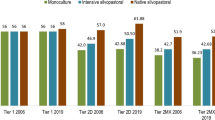Abstract
Computer spreadsheets were developed to evaluate greenhouse gas (GHG) emissions from U.S. beef and dairy livestock systems from nine locations. Of the beef systems the cow-calf herd emitted the most and feedlot cattle the least methane (CH4) and nitrous oxide (N2O) per unit product. Carbon dioxide (CO2) emissions per unit product were the least for the cow-calf and greatest for the feedlot scenarios. In the dairy systems approximately one-half of the total GHG CO2 equivalents were from CH4 and one-third from N2O. Mitigation strategies, such as intensive grazing, reduced GHG emissions by approximately 10%.
Similar content being viewed by others
References
Cederberg C (1998) Life cycle assessment of milk production - a comparison of conventional and organic farming. SIK-Rapport Nr 643, Swedish Institute for Food and Biotechnology, Gothenburg, Sweden
Gibbs M & Johnson DE (1994) Methane emissions from the digestive processes of livestock. In: International anthropogenic methane emissions estimates for 1990, U.S. EPA 230–R-93–010, Washington, D.C., USA
IPCC (1996a) Technologies, Policies and Measures for Mitigating Climate Change, Technical Paper 1. United Nations: New York, USA
IPCC (1996b) Climate Change 1995 Impacts, Adaptations and Mitigation of Climate Change: Scientific Analyses, Cambridge, UK Cambridge University Press
IPCC (1996c) Revised 1996 IPCC Guidelines for National Greenhouse Gas Inventories: Reference Manual. United Nations: New York, USA
National Research Council (1989) Nutrient requirements of dairy cattle, 6th edn. Washington, D.C: National Academy Press
National Research Council (1996) Nutrient Requirements of Beef Cattle, 7th edn., Washington, D.C., USA: National Academy Press
Paustian K, Andren O, Janzen HH, Lal R, Smith P, Tian G, Tiessen H, Van Noordwijk M & Woomer PL (1997) Agricultural soils as a sink to mitigate CO2 emissions. Soil Use & Manage 13: 230–244
Pimentel D (1980) Handbook of Energy Utilization in Agriculture, Ed. D. Pimentel. Boca Raton, FL, USA: CRC Press
RLEP (1998) Ruminant Livestock Efficiency Program, U.S. EPA: Washington, D.C., USA
U.S. EPA (1999) The draft 1999 inventory of U.S. greenhouse gas emissions and sinks 1990–1997: Washington, D.C., USA
Velthof GL & Oenema O (1997) Nitrous oxide emission from dairy farming systems in the Netherlands. Netherlands J Agric Sci 45: 347–360
Author information
Authors and Affiliations
Rights and permissions
About this article
Cite this article
Phetteplace, H.W., Johnson, D.E. & Seidl, A.F. Greenhouse gas emissions from simulated beef and dairy livestock systems in the United States. Nutrient Cycling in Agroecosystems 60, 99–102 (2001). https://doi.org/10.1023/A:1012657230589
Issue Date:
DOI: https://doi.org/10.1023/A:1012657230589




